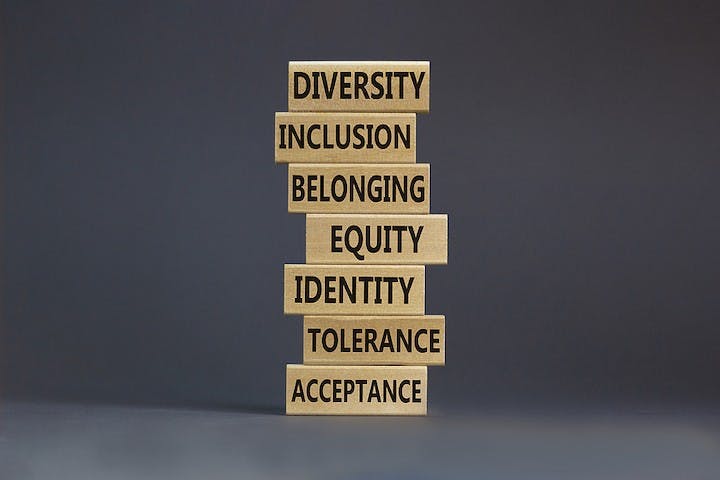Long before the rash of recent news showing companies were jettisoning their DEI leaders and departments, there was an ongoing identity crisis in the diversity office.
The names of the departments alone have gone from Diversity to Diversity and Inclusion to Diversity Equity and Inclusion, while other variations include Diversity and Inclusion with the term Belonging too.
Notwithstanding all of this, occasionally, you might see the term equality. For example, in numerous bold statements, Salesforce aggressively uses the word equality.
By why this word in particular? Salesforce, for example, has embraced the term equality while in other organizations this language often is intentionally deleted from references to any diversity work.
Researching diversity language
To understand this phenomenon, I recently did a survey asking business leaders and non-leader employees to tell us what they think all these words mean, and which terms they prefer.
The overall results were as follows:
Diversity – means that companies are trying to bring different kinds of people into the company.
Inclusion – the company is working on figuring out what to do with those different people
Equity – a nice idea, but no one was clear what the point really was and most found it problematic (including worries about favoritism).
Belonging – this was a mix; we saw some comments about people liking it, and others wondering who or what an employee is supposed to belong to.
Equality – there were far more emotional responses to this term. Employees wanted equal opportunity, but some employers were very fearful of the term. For instance, some cited the work they have done to create merit-based systems, which would then be harmed by any efforts to create equality at work.
In the meantime, we also find that use of any of these terms is raising concerns that organizations are favoring one group over another.
When diversity is discussed, for example, the majority have concerns about their own place within the organization, especially as things promise to change.
Additionally, companies, universities and communities are working to ban the use of diversity, inclusion and equity departments, personnel and more.
So…do we need to change our language about diversity?
Given that the goal of all these DEI/HR efforts is something other than favoritism, maybe it’s time to change the language to a term that is more over-arching and business focused.
It is important to note that I am not trying to suggest a lessening of the importance of diversity, but merely a change in language that really does denote fairness and equal opportunity for everyone. The goal is creating level playing field language.
The story of business capital
So what could this new language be?
Well, for starters there is an abundance of research focused on understanding various types of business capital and how to leverage this capital to create competitive advantage.
For example, most companies have financial capital, technology capital, and human resources capital. Additionally, every organization has relational capital, and although most never measure it (thus, they are not managing it), relational capital is perhaps the most important for strategy, long-term competitive advantage and for differentiating the business from their competition.
Maximization of relational capital means improving relationships internally and externally with ALL types of people.
So is this not what we are trying to do in all the diversity-related initiatives?
Leaders want to create an organizations that understand their diverse client base, employee base, potential client base, potential employee base and potential community partners.
One measure of optimized or maximized relational capital value is the types of groups in which an organization has relationships, and the second measure is the quality of those relationships. A third measurement exercise would involve assessing which relationships are strong and which are weak, and then develop strategies for fixing problems.
If this were the job of a department, the Chief Relational Officer would be responsible for more than just diversity.
This job would be focused on looking at relationships with different subsets of employees, examining resources provided to these people, and making sure relationships with everyone (majority and minority groups), are positive and helping the company grow.
They would also help employees learn how to sustain strong and positive relationships with each other, as well as with partners, vendors, suppliers, community members and customers.
Language used by the chief relational officer language would serve to put all people and employees on the same playing field.
It does tend to focus more on equality, but not in a way that alienates anyone, because the focus is on equal opportunity, equal access, and equal relational value.
Relational capital is powerful
Relational capital is not a new concept.
I have done research looking at relational capital vis-à-vis other sources of capital in numerous studies, and the research continues to find that higher levels of relational capital have positive effects on organizational outcomes.
What is new, I believe, is that now is a time for making some radical changes in how we think about diversity.
The current model of creating various compilations of the same terms (and changing out which one comes first, second or third – least from the perspective of the employees and perhaps other stakeholders – will likely not herald in the type of new attitudes, behaviors, measurement systems and more that are needed.
I invite comments on making some bolder changes, starting with how we label the groups responsible for relational capital – beyond diversity.
Also, if anyone would like to engage in measuring relational capital and understanding organizational strengths and weaknesses in this area, you can join our ongoing research initiative by reaching out to me at theresa@eepulse.com.
